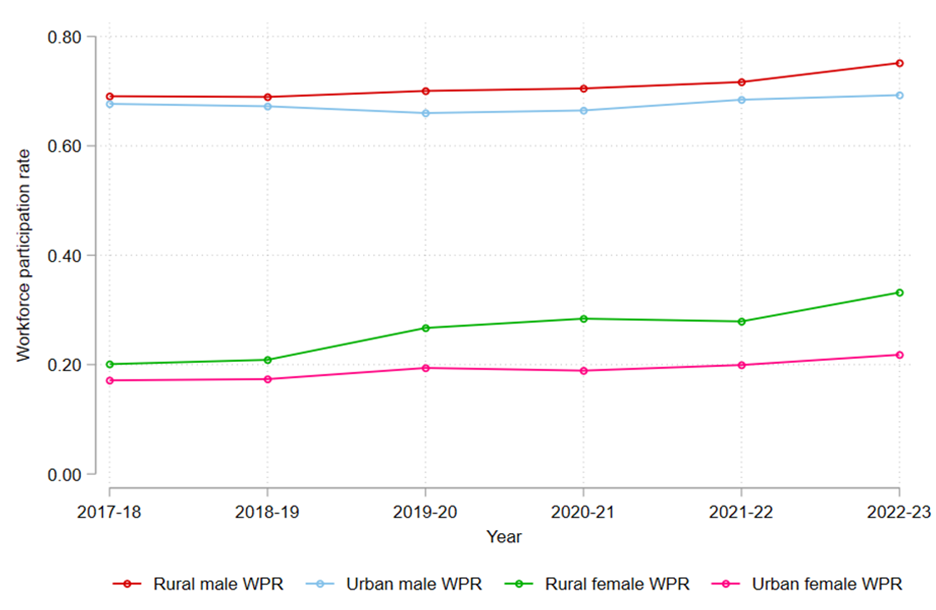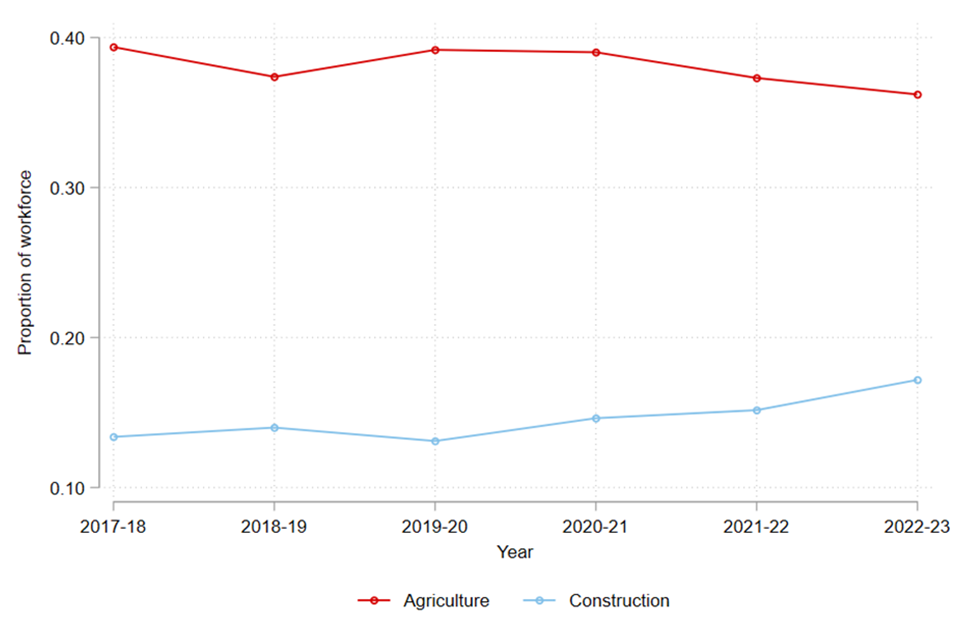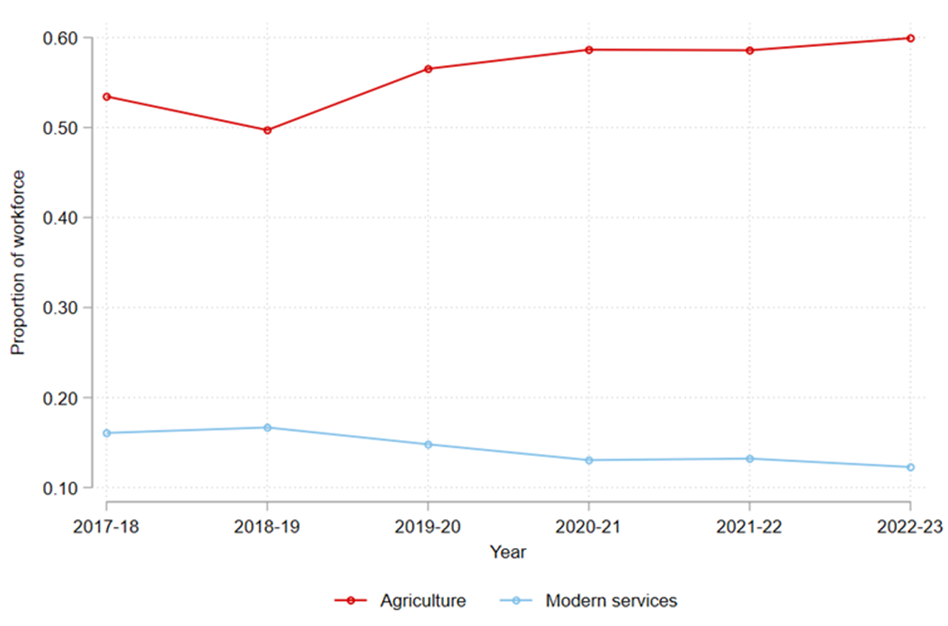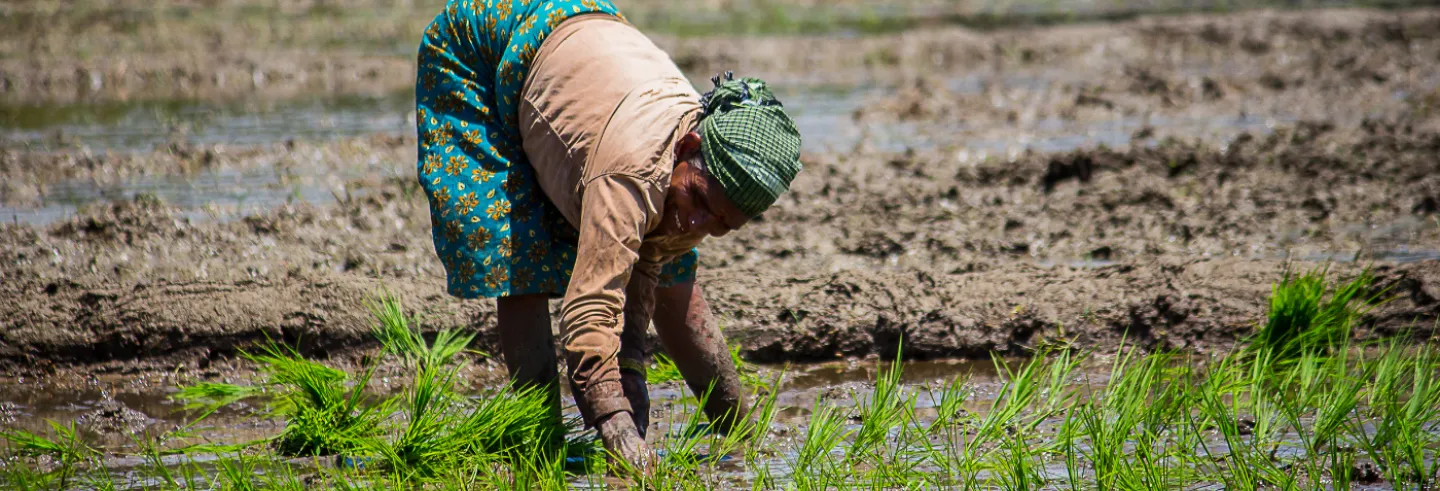The Ministry of Statistics, Planning and Implementation recently released the Annual Report of the Periodic Labour Force Survey (PLFS) (June 2022–July 2023). With the PLFS reporting the highest workforce participation rate (WPR) and the lowest unemployment rate (UR) in the last six years, most of the mainstream press reported an improvement in the Indian labour market.
However, a rising WPR and falling UR need not necessarily be good indicators in themselves. It is important to look at what kinds of jobs have been created and if average earnings have gone up over time.
Figure 1 shows that the increase in the overall WPR was the result of more rural women entering the workforce from 2017-18 to 2022-23 (the WPR for rural women rose from 20% to 33%). After falling or being stagnant after 2004, the female WPR has risen since 2019. The explanation is that led by distress, it is mainly self-employment in agriculture that has risen (State of Working India (SWI) 2023). Therefore, it makes sense to see which sectors have contributed to increasing employment and what kind of jobs have been created.
Figure 1: Rising Workforce Participation Rate Driven Mostly by Rural Women

Note: Employment is defined based on the current weekly status.
Figure 2 shows the proportion of male workers engaged in the agriculture and construction sectors. The share of agriculture has continued to come down and is lower than pre-pandemic levels, but the share of the construction sector has increased over time, implying the movement of people from agriculture to construction. The share of other sectors such as manufacturing, traditional services, and modern services has remained more or less constant for men.
Figure 2: Shift from Agriculture to Construction (Male Workers)

Note: Employment is defined based on current weekly status.
Figure 3 shows the proportion of working women engaged in the agriculture sector and in the modern services sector (health, education, information technology, and the like). The share of working women in agriculture has increased over time and is still above the pre-pandemic level. However, the share of women in modern services has gone down over time (0.17 in 2018-19 to 0.12 in 2022-23). The proportion of women working in modern services had been increasing during the high growth phase of the Indian economy, as highlighted in SWI 2023, but since 2021 this has been falling and the 2022-23 data shows the same trend.
This is worrisome because it indicates the reversal of structural change. One should not interpret the falling share of female employment in the modern service sector and the rising share in the agriculture sector as a movement from the former to the latter because they are two different groups of women. The share of female employment in manufacturing, construction, and traditional services has remained the same. In comparison to men, the share of female employment in agriculture is very high (0.60 vs 0.36 in 2022-23).
Figure 3: Share of Agriculture Sector in Total Female Employment Increases and the Share of Modern Services

Note: Employment is defined based on current weekly status.
The rising share in agriculture and the falling share in modern services indicates the kind of employment (casual or self-employed or regular salaried) women are more likely to be in. Figure 4 shows the share of females in different kinds of employment and one can see that the share of self-employment has increased while that of regular wage and casual employment has fallen.
This is important to highlight because the share of women in self-employment is now at an all-time high since 1983. The last time it crossed 60% was in 2004 when there was widespread rural distress. Within self-employment, the share of unpaid household helpers has increased from 26% to 33% of the workforce, which means one in three women is working as unpaid household helpers. For males, the share of different employment types has remained the same.
In terms of structural change, the recent period for women has not been good because there is a reversal of structural change in both the Lewisian framework (proportion engaged in regular wage or salaried work as opposed to casual wage work or self-employment) as well as the Kuznetsian framework (a rise in the proportion of workers engaged in non-agricultural activities). The pandemic-induced reversal of structural change was recently discussed in this article in The India Forum.
Figure 4: Share of Women in Self-employment Rising after Pandemic

Note: Employment is defined based on current weekly status.
As more women have entered the workforce, mostly due to rural distress rather than an increasing demand for labour and have crowded into the self-employment sector, competition has intensified. This is supported by trends in the earnings data.
On the earnings side, there has been either no change or a fall in real earnings other than for casual workers in the last six years. Figure 5 shows the average monthly earnings from self-employment for males and females in the last six years adjusted for inflation. For male workers, the earnings have increased from Rs. 13,613 to Rs. 15,275. For women, there has been a fall in real earnings. Further, the gap between the self-employed earnings of men and women has increased over time.
Figure 5: Stagnant Self-employment Earnings for Women

Note: At 2023 constant rupees.
For regular wage workers, the average monthly earnings have remained almost the same as at pre-pandemic levels for both males and females. In 2017-18, the real monthly earnings for men were Rs. 21,138, which fell to Rs. 20,907 in 2022-23, and the corresponding figures for women were Rs. 16,084 in 2017-18 and Rs. 15,997 in 2022-23.
Lastly, the earnings for casual workers have increased for both males and females. (The monthly wage for casual workers is calculated by multiplying the weekly wage by 4, to make it comparable with a monthly salary.) The average wages for men has increased from Rs. 7,906 to Rs. 9,122 in the last six years and for women from Rs. 4,724 to Rs. 5,296.
In comparison to the earnings from self-employment for women, casual earnings were approximately 80% in 2017-18, which has increased to almost equal in the recent PLFS round. The increasing ratio of casual earnings to self-employed earnings for women again highlights that a lower level of demand in the labour market has resulted in lower per person earnings from self-employment.
In sum, one should not put too much emphasis on the rising WPR as reported in the latest PLFS report. As noted in SWI 2023, if work participation rises because of economic growth and a rising demand for labour, it has very different implications from when it rises because of stagnant household incomes, which force women into self-employment.
Akshit Arora is with Azim Premji University, Bengaluru.









